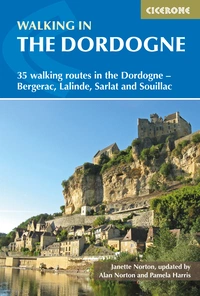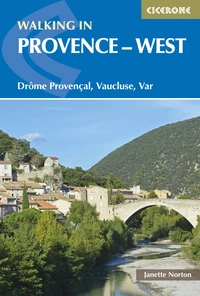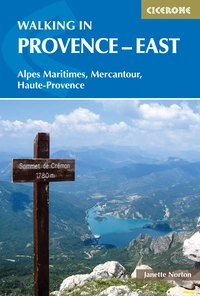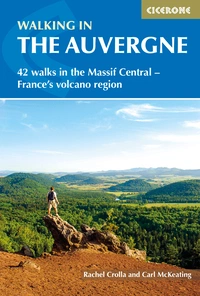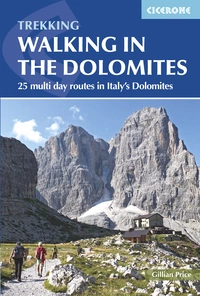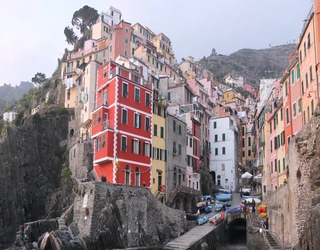Walking in the Dordogne – what you need to know
The Dordogne region is steeped in history, with bastide towns, Romanesque churches and Renaissance-style châteaux to visit, as well as rock shelters and caves along the nearby Vézère river, their walls decorated by paintings created by early man. One of the most beautiful areas of France, the landscape is still peaceful and unspoilt, with a mild climate and delicious food and wine. Here's everything you need to know about walking in the region.
| What? | 35 varied walks in the Dordogne region |
| Which areas are covered? | The Sarlat and Souillac regions (Perigord Noir) and Bergerac (Perigord Poupre). The walks in this guidebook are grouped into four sections, around the towns of Bergerac, Lalinde, Sarlat and Souillac. |
| How long are the routes? | Between 6 and 16.5km |
| How long do the walks take? | Between 1hr 45 and 5hr 45 |
| Which season is best for walking? | May, June, September and October |
| How to get to the Dordogne? | Many of the walks in this book cannot be reached without a car. If you come by train or air, all the main car hire firms operate from stations and airports, and information about rental can be obtained before you leave. |
| What accommodation is available? | The Dordogne is a major tourist destination so there is plenty of accommodation to choose from, ranging from four-star hotels to campsites. If you plan to visit in the summer months or at holiday periods, it is advisable to book in advance. |
| Are the routes well waymarked? | The walks in the Dordogne area are well signed, but it is a region criss-crossed with paths and narrow roads, and one walk can sometimes cross another, marked in the same way. It is best to follow the route description carefully as when there is danger of taking the wrong turning, this is indicated. |
| How hard are the walks? | The circular routes are for all abilities. |
| What maps do I need? | A good map that gives an overall picture of the Dordogne and Lot is the Michelin Carte Routière et Touristique 1:150,000 Périgord Quercy. |
| Must see? | The Dordogne river with dramatic horseshoe meanders and quiet stretches for boat trips on traditional gabarres; the cliffs of the Vézère with caves and overhangs where early man made his home; the arid causses and subterranean gauffres in the south; medieval castles and towns, Renaissance-style chateaus, Romanesque churches. |
| Around Bergerac | Length | Grade | Time |
|---|---|---|---|
| Along the river at Bergerac | 7.5km | Easy | 2hr |
| The vineyards of Monbazillac | 6km | Easy | 1hr 45min |
| Flaugeac to the Château de Bridoire | 12km | Medium | 3hr 45min |
| Around Monestier | 15km | Medium | 5hr |
| Round the Lac de l’Escourou | 8km | Easy | 2hr 15min |
| Boucle d’Issigeac | 17km | Medium | 5hr |
| The Conne river valley | 11km | Easy | 2hr 45min |
| Boucle de St-Aubin | 11km | Easy | 3hr |
| St-Georges-de-Montclard | 8.5km | Easy | 2hr 30min |
| Around Lalinde | Length | Grade | Time |
|---|---|---|---|
| St-Félix-de-Villadeix | 12.5km | Easy | 3hr 30min |
| Couze to the Château de Lanquais | 11km | Easy | 2hr 45min |
| The heights and river at Lalinde | 16.5km | Medium | 4hr 30min |
| Above Mauzac | 10km | Easy | 2hr 30min |
| The Cingle de Trémolat | 10.5km | Easy | 2hr 45min |
| Limeuil and the Vézère river | 13.5km | Medium | 4hr 15min |
| Above the Abbey of Cadouin | 9km | Easy | 2hr 45min |
| Beaumont and the Rocher du Corbeau | 14.5km | Medium | 3hr 45min |
| Monpazier and the Château de Biron | 18km | Medium | 4hr 45min |
| Around Sarlat | Length | Grade | Time |
|---|---|---|---|
| Around les Eyzies | 13km | Medium | 3hr 45min |
| Along the Vézère river | 18.5km | Medium | 5hr 45min |
| Boucle de Coulonge at Montignac | 13.5km | Medium | 4hr |
| Around St-Geniès | 13.5km | Medium | 4hr |
| St-Crépin and Carlucet | 7km | Easy | 2hr |
| Les Jardins d’Eyrignac | 12.5km | Medium | 3hr 45min |
| South of the Château des Milandes | 15km | Medium | 4hr 15min |
| Le Chemin de Cazenac from Beynac | 11.5km | Easy | 3hr |
| Around la Roque-Gageac | 9.5km | Easy | 3hr 15min |
| The bastide town of Domme | 9.5km | Easy | 3hr |
| Boucle de Veyrignac | 12.5km | Medium | 3hr 45min |
| Around Souillac (Lot) | Length | Grade | Time |
|---|---|---|---|
| Gourdon and the Bléou valley | 6.5km | Easy | 1hr 45min |
| Roc des Monges from Saint-Sozy | 8km | Easy | 2hr 30min |
| Martel to Mont Mercou | 16.5km | Medium | 4hr 30min |
| Rocamadour and the mills of the Alzou Gorge | 14.5km | Medium | 4hr 30min |
| Alvignac and the Source Salmière | 8.5km | Easy | 2hr 30min |
| The Gouffre de Padirac and Causses de Quercy | 14km | Medium | 4hr 15min |
Walking in the Dordogne
35 walking routes in the Dordogne - Bergerac, Lalinde, Sarlat and Souillac
£17.95
This guidebook describes 35 walking routes in France's beautiful Dordogne region, based around Sarlat and Souillac regions (Perigord Noir) and Bergerac (Perigord Poupre). The walks range from short walks to mountain circuits, and explore the spectacular gorges, chateaux and medieval villages of the region.
More information
